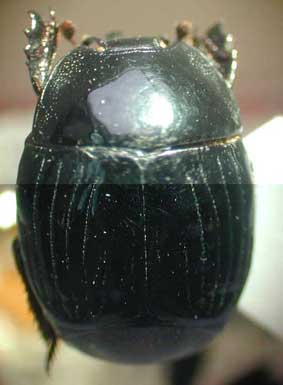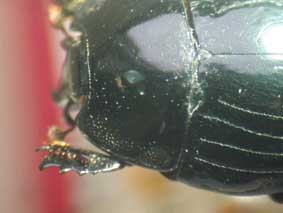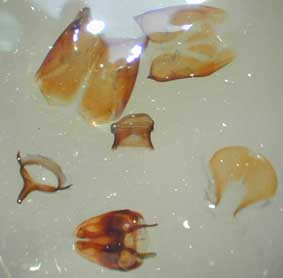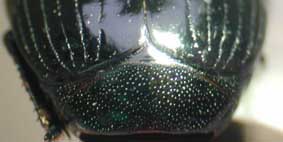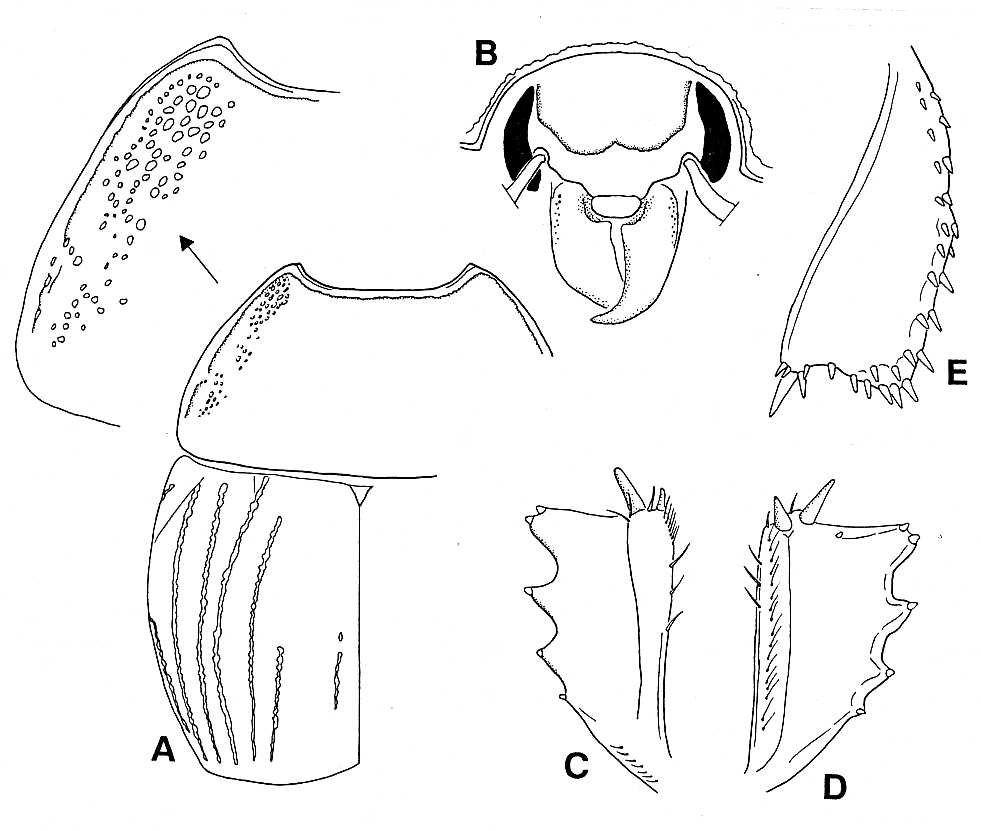
Merohister uenoi M. Ôhara, 1992b: 495.
Japanese name: Amami-emma-mushi.
Description. Male. Body oblong-oval, black and shining; tarsi and antennae, except scape, reddish brown. Body length PPL 9.23 mm, PEL 7.70 mm. Width 6.46 mm. Biometric data are as follows: APW 2.46 mm, PPW 6.0 mm, PL 2.92 mm, EW 6.46 mm, EL 4.3 mm, ProW 4.46 mm, ProL 1.85 mm, PyL 1.54 mm, PTL 2.23 mm, MTL 2.15 mm, MMTL 2.69 mm.
Frontal stria of head (Fig. 1 B) complete and well impressed, its basal half of lateral portion straight and its apical half obliquely extending inwards, and the apical portion nearly straight but slightly and inwardly angulate at middle; disk of head evenly covered with fine punctures which are separated by four to five times their diameter. Labrum transversely oblong. Mandible stout and well developed.
Marginal pronotal stria (Fig. 1 A) complete laterally and broadly interrupted behind head anteriorly. Pronotal lateral stria nearly complete, deeply impressed and crenate, but shortly interrupted at basal two-thirds, the basal end not attaining to the basal margin of pronotum. Disk of pronotum shining and sparsely clothed with microscopic punctures; the lateral fifth with punctures, which are dense and large on apical half and becoming sparser and fewer of number on basal half (Fig. 1 A, 2 B). Antescutellar area with a short longitudinal impression.
Epipleural marginal stria weakly impressed on median third of elytra (Fig. 1 A). Elytral marginal stria deep carinate and nearly complete. Epipleura deeply excavated on apical two-thirds, and its disk sparsely and coarsely punctate. External subhumeral stria crenately present on humerus, of which length is the same as one-third of the length of elytra. Internal subhumeral stria on apical half. First to 3rd dorsal striae complete and coarsely crenate. Fourth dorsal stria abbreviated on basal sixth. Fifth dorsal stria present on apical third. Sutural stria obsoletely impressed on medio-apical one-fourth. Disk of elytra with punctation same as that of pronotum, and subapical impression on lateral third.
Propygidium (Fig. 2 C) with broad and feeble impression on each side, and irregularly covered with coarse punctures which are separated by one to three times their diameters, and becoming denser along basal margin; fine punctures intermingled with coarse ones, and evenly separated by about four times their diameter; area between these punctures with alutaceous sculptures. Pygidium (Fig. 2 D) densely covered with coarse punctures which are separated by half to two times their diameter; area between coarse punctures sparsely clothed with fine punctures; these punctures becoming finer along apical margin.
Anterior margin of prosternal lobe nearly round, the lateral portion strongly convergent apically and the anterior portion obtusely angulate at middle; marginal stria of lobe carinate and complete; each lateral area with another lateral margin outside the marginal stria. Disk of lobe densely covered with coarse punctures, the punctures becoming finer medially. Prosternal keel shining, sparsely clothed with fine punctures which are separated by two to four times their diameter. Descending lateral stria complete and deeply impressed.
Anterior margin of mesosternum strongly emarginate at middle. Marginal stria carinate and complete, and another stria present behind each anterior angle. Disk of mesosternum sparsely clothed with fine punctures. Meso-metasternal suture carinate and angulate at middle. Lateral metasternal stria extending obliquely and posteriorly, and united with oblique stria which extends inwardly from the middle of metasternal-metepisternal suture. Mesocoxal stria complete, well impressed, extending along mesocoxa medially and becoming divergent from posterior margin of mesocoxa outwardly. Intercoxal disk of metasternum clothed with fine punctures similar to mesosternal ones; each area before metacoxa obliquely present short stria. Lateral disk densely covered with large punctures which are setiferous and becoming smaller inwardly.
Punctation of 1st abdominal sternum same as that of metasternum; 1st abdominal stria complete and well carinate.
Protibia (Fig. 1 C, D) with 5 denticles on outer margin, the apical angle bearing two denticles. Meso- and metatibiae (Fig. 1 E) multidentate. All tibiae dilated.
Male genitalia (Fig. 3): paramera short and stout; spicules completely sclerotized as a ring the basal piece is fitted into.

Etymology. The specific epithet is given in horor of Dr. Shun-Ichi Uéno who gave me the oppotunity to study the specimen.
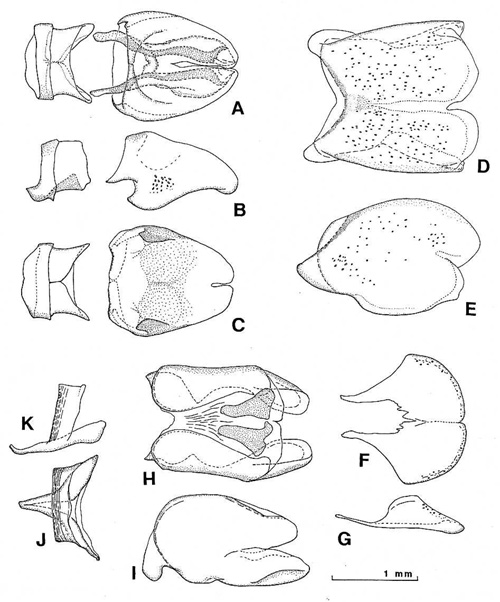
Remarks. This new species is similar to Merohister aino in general appearance,
but distinguished from the latter by the larger body size, absence of coarse
punctation of front and entirely different structure of male genitalia.
Specimens examined. Holotype; male, Hatsuno, Amami-Ôshima, Nansei Isls., Japan, 6/vii/1962, N. Ôbayashi leg. (NSMT).
